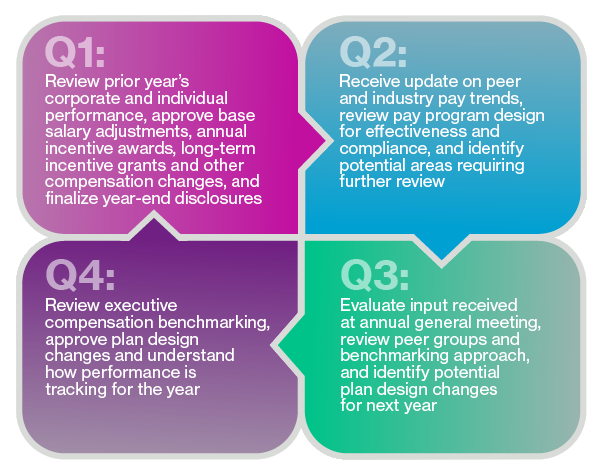Remuneration committees should have an annual meeting calendar, laying out the agenda for each regular meeting through the year, which aligns with the company’s fiscal year and HR and compensation cycles.
As articulated in its charter, the remuneration committee is directly accountable for overseeing the company’s executive compensation programs. This includes the development of a compensation philosophy that aligns with the company’s business strategy, the annual review of company and senior executive performance and its impact on pay, and regular monitoring of the executive compensation programs relative to market and governance trends. Increasingly, the charter is expanding to provide for greater oversight of the company’s various human resource programs, including succession planning and talent development efforts.
To support these efforts, remuneration committees should have an annual meeting calendar, laying out the agenda for each regular meeting through the year. These agendas should follow a natural cadence that aligns with the company’s fiscal year and HR and compensation cycles.
The first step in drafting the calendar is to confirm that the committee’s charter or terms of reference are up-to-date and then to break it down into specific items. A responsibility matrix can be developed to clarify when and how each item needs to be addressed. The matrix includes the role of the committee, management and their advisors on each item, and when each item needs to come forward for input, review, approval and/or recommendation to the board.
The second step is to allocate each item to a specific committee meeting, with some items being brought forward numerous times for input, review and approval. Once all the committee’s action items are identified and aligned to the company’s HR calendar, it is often apparent that one or two meetings per year are inadequate to address all the items. Increasingly, Asian remuneration committees are setting four regular meetings per year. With such a schedule, each of the agenda items can generally be aligned with the following timing:

The third step is to prioritize the agenda for each meeting to ensure that sufficient time is spent on decision items, with discussion/review items positioned closer to the end of the meeting. In many cases, consent agendas are used to group standard reporting items together without having specific discussion at the meeting, unless questions are raised on these items by the committee members.
Sufficient time must be provided for everyone to prepare and review the materials in advance of the meeting. This includes an initial meeting to review and confirm the agenda items six to eight weeks in advance, draft materials shared with the committee chair two to three weeks in advance and send final materials to the committee at least one week in advance. Depending on internal review cycles, materials might need to be ready earlier for review by the CEO and executive management.
A committee calendar that articulates the agenda items, timing and responsibilities, ensures that all stakeholders in the process have sufficient time to review and discuss, and that the remuneration committee can effectively oversee all relevant pay and incentive processes with sufficient input and dialogue with management.
*This is based on an article written by Ryan Resch, a Willis Towers Watson managing director based in Toronto.